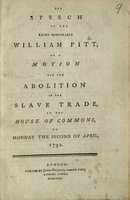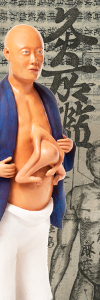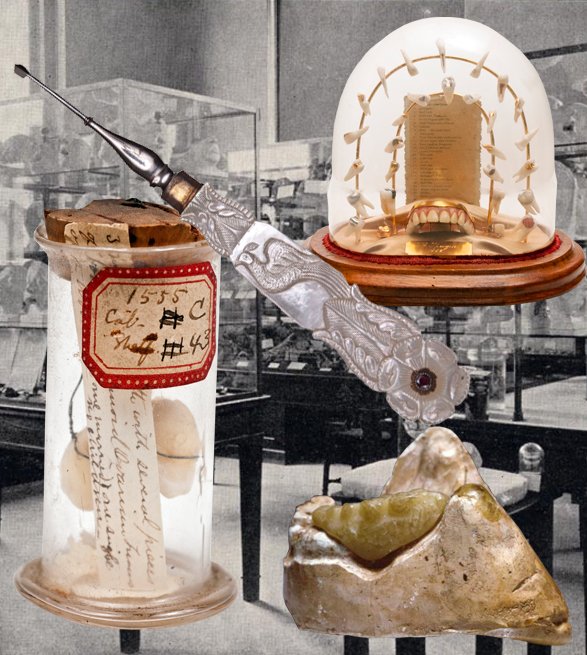Browse Exhibits (9 total)
"This Abominable Traffic" : Physicians on Slavery

 As Harvard University and other American educational institutions grapple with their historic ties to slavery and its legacy, this display, drawn from the rare book and manuscript collections of the Countway Library's Center for the History of Medicine highlights some of the medical aspects of slavery and racism. Physicians of the 18th and 19th centuries were some of the most well-travelled individuals of their day and had many opportunities to witness slavery in the West Indies and United States. Their travel narratives provide firsthand accounts of the experiences of slaves, their medical care, and treatment by owners and slaveholders.
As Harvard University and other American educational institutions grapple with their historic ties to slavery and its legacy, this display, drawn from the rare book and manuscript collections of the Countway Library's Center for the History of Medicine highlights some of the medical aspects of slavery and racism. Physicians of the 18th and 19th centuries were some of the most well-travelled individuals of their day and had many opportunities to witness slavery in the West Indies and United States. Their travel narratives provide firsthand accounts of the experiences of slaves, their medical care, and treatment by owners and slaveholders.
Beyond the Bone Box
Drawing on the rich connections between the holdings of the Warren Anatomical Museum (WAM) and the manuscripts, archival, and rare book collections housed in the Center for the History of Medicne (CHoM), Beyond the Bone Box is a pilot project to build circulating special collections resources with which students of multiple disciplines can physically engage with artifact and document surrogates anywhere on the Harvard campus.
Inspired by Harvard Medical School’s retired bone box program, which allowed medical students to borrow sets of human bones for home study, and developed in partnership with Harvard faculty, curators, archivists, and librarians, this project develops circulating resources that contain 3D-printed copies of WAM case studies that our highly contextualized with surrogates of special collections materials. Through this program, the Center seeks to democratize access to unique and sensitive collections through quality fungible surrogates and engender new forms of engagement with Harvard’s special collections across its library system.

Credits
Beyond the Bone Box was funded by a Harvard Library S. T. Lee Innovation Grant starting in 2018. The project was designed by Warren Anatomical Museum Curator, Dominic Hall, and implemented by Museum Programming Assistant Alyssa Brophy. Initial Bone Box case studies were curated by Hall, Anne Harrington, Ph.D (Franklin L. Ford Professor, Faculty Dean, Pforzheimer House, Harvard University), and Julie Reed (Teaching Assistant in History of Science, Harvard University) with input from the spring 2019 students of Harvard HS 97.
Further collaboration on the case of Phineas Gage was provided by Dana A. Stearns, M.D. (Assistant Professor of Emergency Medicine, Director of Anatomy Education for Pathways, Massachusetts General Hospital, Harvard Medical School) and Sabine Hildebrandt, MD (Associate Professor of Pediatrics, Lecturer on Global Health and Social Medicine, Boston Children’s Hospital, Harvard Medical School). Administrative and description support was providing by Emily Gustainis (Deputy Director, Center for the History of Medicine, Countway Library of Medicine) and Jessica Sedgwick (Collections Services Archivist, Center for the History of Medicine, Countway Library of Medicine). Graham Holt (Director of the Office of Creative Solutions, Laboratories of Cognitive Neuroscience, Boston Children's Hospital) developed the initial Phineas Gage 3D print from CT scans taken by Peter Raitu and Ian Talos (Surgical Planning Laboratory, Brigham & Women’s Hospital), and provided technical guidance for the 3D printing workstation at the Center for the History of Medicine.
Bigelow-Wallis and Warren-Kaula Teaching Watercolors

The Bigelow-Wallis and Warren-Kaula watercolor collection is a series of works in Warren Anatomical Museum originally compiled by the Harvard Medical School Department of Anatomy for use in the anatomical lecture hall. The average size of the watercolors is 69 cm wide x 100 cm high and the works are mounted with metal grommets in the corners for hanging. The bulk of the collection is the 189 works commissioned by Harvard Medical School Professor of Surgery Henry Jacob Bigelow from lithographer Oscar Wallis between 1849 and 1854. The remaining 46 watercolors in the collection were painted circa 1894 by William Jurian Kaula for Harvard Medical School Moseley Professor of Surgery John Collins Warren. The Department of Anatomy combined the two physician-artist collaborations into one teaching series within the Warren Anatomical Museum in the early 20th century.
Body of Knowledge, A History of Anatomy (in 3 parts)

Submissions from the Center of the History of Medicine to the physical and electronic components of the exhibition, Body of Knowledge, A History of Anatomy (in 3 parts), on display from March 6, 2014 to December 5, 2014 at the Collection of Historical Scientific Instruments and in the companion Gallery Guide.
Charles Lowell's Hip: An Early Case of (alleged) Medical Malpractice
Charles Lowell infamously suffered a well-publicized and controversial hip dislocation. A young man at the time of the incident in 1821, he charged his physicians with malpractice and negligence, arguably helping to start a wave of medical lawsuits. The case was filled with speculation and accusation, but never arrived at a satisfactory conclusion. Years after the court was adjourned, however, Lowell stood to testify as the final witness when, upon his death, his pelvis was prepared and donated. Never pleased with the judicial resolution to drop the case, he advocated for a post-mortem examination in the hopes that the bone could expose all unanswered questions, and prove once and for all that he had been wronged.
Complementary Therapies: Masterworks of Chinese and Botanical Medicine


While large numbers of Americans are now seeking health care and therapies outside of mainstream Western medicine, there is a long and rich history of alternative medical treatments. Botanical medicine, which uses herbs and natural remedies, and traditional Chinese medicine, which combines botany with practices like acupuncture and moxibustion, are two of branches of alternative medicine – "complementary therapies" – that are believed to work alongside conventional treatment. Complementary Therapies brings to light some of the treasures of the collections of the Center for the History of Medicine and includes the first Western texts dealing with Chinese medicine and acupuncture; a copy of John Gerard's 1636 Herball; rare publications from the Thomsonian botanical movement; Lam Qua watercolor studies of tumor patients treated in Canton in the 1840s; and a model of Aké, a Chinese youth with a parasitic twin, and an account of his case from 1821.
Lost Museum of Harvard's Dental School

Nearly as old as the Dental School itself, Harvard's Dental Museum was originally intended to display specimens of mechanical dentistry prepared by graduating students. It soon became a repository for specimens of human and comparative odontology, pathology, and anatomy, instruments, models, photographs, and lantern and stereoscopic slides. The Museum also housed some unusual historical items.
The published Announcement of the Dental School for 1937 has a brief but detailed description of the Dental Museum, and information about the collection had been included in the annual catalogs for the past sixty years. In the following year's edition of the Announcement, however, no entry for the Museum is included, and one never appears again. Just what happened to Harvard's Dental Museum, and where are its collections now?
Plethysmograph Research in the Department of Physiology at the Harvard T.H. Chan School of Public Health, 1950-1980
This exhibit uses three objects, two plethysmographs and a spirometer, to celebrate the legacy of the Department of Environmental Health at the T.H. Chan School of Public Health.
Scalpel and the Pen

Physician, lecturer, novelist, inventor, historian, anatomist, humorist—and poet, professor, and autocrat of the breakfast-table—Oliver Wendell Holmes (1809-1894) has been called “the most successful combination which the world has ever seen of the physician and man of letters.” This exhibit, The Scalpel and the Pen, takes its name from that idea and explores all the different sides of the personal and professional career, in both literature and medicine, of this true Boston original.
